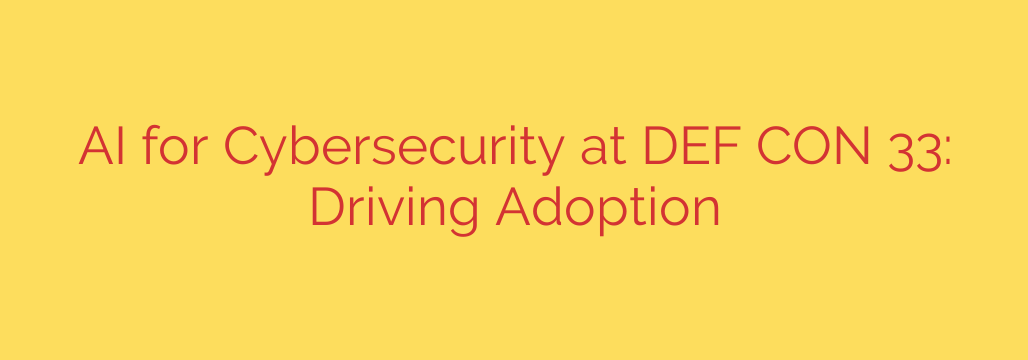
AI in Cybersecurity: From Conference Buzz to Real-World Defense
The cybersecurity landscape is locked in a perpetual arms race. As digital threats grow more sophisticated and attack surfaces expand, security teams are struggling to keep pace with the sheer volume of data and alerts. In this high-stakes environment, Artificial Intelligence (AI) is no longer a futuristic concept—it’s emerging as a critical ally for defenders on the digital front lines.
Discussions among industry leaders, particularly at major security conferences, are shifting from the theoretical potential of AI to the practical realities of its implementation. The core challenge now is not if we should use AI, but how to drive its adoption effectively and responsibly within security operations.
Supercharging Security Operations with AI
AI, and its subset machine learning (ML), offers a fundamental advantage: the ability to process and analyze data at a scale and speed that is impossible for human analysts alone. This capability is transforming core security functions.
Proactive Threat Detection and Hunting: Traditional security tools rely on known signatures to identify malware and attacks. AI-powered systems, however, can establish a baseline of normal network activity and identify anomalies and subtle deviations that signal a novel or zero-day attack. This allows Security Operations Centers (SOCs) to move from a reactive posture to a proactive one, hunting for threats before they can cause significant damage.
Automated Vulnerability Management: Manually prioritizing which vulnerabilities to patch first is a daunting task. AI algorithms can analyze countless factors—including asset criticality, threat intelligence feeds, and the likelihood of exploitation—to provide a highly accurate, risk-based priority list. This ensures that security teams focus their limited resources on the most critical threats first.
Accelerated Incident Response: When a breach occurs, every second counts. AI can dramatically speed up the incident response lifecycle by automating the initial investigation, correlating alerts from various sources, and even suggesting containment actions. This frees up human analysts to focus on strategic decision-making and complex forensic analysis rather than getting bogged down in repetitive tasks.
Overcoming the Hurdles to AI Adoption
Despite the clear benefits, integrating AI into existing security workflows is not without its challenges. The journey toward full adoption requires addressing several key obstacles.
First is the trust and transparency issue, often referred to as the “black box” problem. Security professionals need to understand why an AI system flagged a particular activity as malicious. Modern AI security platforms are increasingly focused on providing explainable AI (XAI), which offers clear reasoning behind its decisions, building confidence and enabling analysts to validate findings.
Second, there is a significant cybersecurity skills gap. Teams need personnel who not only understand security principles but also have the data science skills to manage, train, and interpret AI models. Organizations must invest in upskilling their existing workforce and training the next generation of security professionals to be AI-literate.
Finally, data quality is paramount. An AI system is only as good as the data it’s trained on. Poor or biased data will lead to inaccurate results and a flood of false positives. A crucial first step for any organization is to ensure they have clean, well-structured, and comprehensive data feeds to power their AI tools effectively.
The Rise of Generative AI: A Double-Edged Sword
The arrival of powerful Large Language Models (LLMs) and other forms of generative AI has added a new dimension to the conversation. While these tools can be weaponized by threat actors to create highly convincing phishing emails or generate polymorphic malware, they also offer immense potential for defenders.
Security teams can leverage generative AI to instantly summarize complex threat intelligence reports, generate scripts for incident response, and even simulate attack paths to identify weaknesses in their defenses. The key is to embrace these tools for defensive purposes faster than adversaries can exploit them for offense.
Actionable Steps for Integrating AI into Your Security Strategy
Moving from theory to practice requires a clear plan. Here are some actionable tips for organizations looking to leverage AI for a stronger security posture:
- Start with a Specific Use Case: Don’t try to boil the ocean. Identify a single, high-impact area where AI can deliver clear value, such as alert triage or phishing detection. A successful pilot project can build momentum for broader adoption.
- Prioritize Data Hygiene: Before investing in an expensive AI platform, ensure your data collection and management processes are robust. Centralize your logs and telemetry to create a clean, reliable data source for the AI to analyze.
- Invest in Your People: Provide training to your security team on how AI tools work, how to interpret their outputs, and how to work alongside them. The goal is to create a human-machine team that outperforms either one alone.
- Partner with the Right Vendors: Scrutinize AI security vendors carefully. Look for solutions that prioritize explainability, integrate easily with your existing security stack, and offer strong support.
The future of cybersecurity is one of collaboration—not just between teams, but between humans and machines. AI is not a replacement for skilled security professionals; it is a force multiplier that empowers them to defend their organizations more effectively and intelligently than ever before.
Source: http://security.googleblog.com/2025/09/accelerating-adoption-of-ai-for.html








